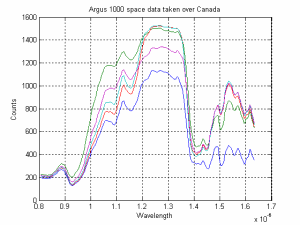Greenhouse-Gas Monitoring Technology
Thoth Technology has developed microsatellite technology to measure greenhouse gases from space in the surface-troposphere region. The Argus IR spectrometer identifies sources and sinks of atmospheric pollution, improving our understanding of global climate science.
The first flight demonstration of Argus technology was in April 2008 aboard the CanX-2 microsatellite, winning CASI’s Alouette Award; the instrument is currently operational. Argus spectrometers are available in a range of qualification levels from laboratory to space grade.
Here is some of the spectral data the first instrument has gathered. These spectra were acquired over Ontario, Canada, on December 12, 2008. At long wavelengths, carbon dioxide exhibits a characteristic absorption fingerprint that can be seen in the spectra on the right hand side. Computer analysis of the Carbon Dioxide feature at 1.6 microns using GENSPECT provides accurate estimates of greenhouse gas concentrations on a one-kilometer grid. Calibration and in-orbit performance of Argus 1000 is published in the Journal of Applied Remote Sensing, 2010.
 Figure 1: Raw counts from Argus 1000 spectrometer for four successive images of 1.25 kilometer surface tiles. Variation in counts between spectra reflects different cloud contamination. Carbon dioxide absorption features are visible at 1.6 microns. Strong water vapor absorption is evident at 1.4 microns.
Figure 1: Raw counts from Argus 1000 spectrometer for four successive images of 1.25 kilometer surface tiles. Variation in counts between spectra reflects different cloud contamination. Carbon dioxide absorption features are visible at 1.6 microns. Strong water vapor absorption is evident at 1.4 microns.